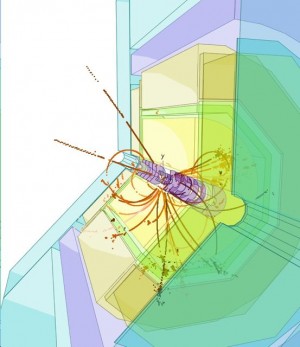Collisions in the LHC are like fireworks. At energies no other particle collider has ever reached, protons smash into protons and produce such exciting particles as the Higgs boson. The catch: many, many things go on at these collisions, and filtering out the interesting ones is possible, but hard. What is more, LHC physicists can never know for sure what went into the original collision at which energy because protons consist of quarks and gluons, which all can interact and which carry a part of the total energy of the proton.
Enter the linear collider: with the electron and positron being fundamental particles, the energy of the interaction is precisely known, and can be traced back to the last electronvolt. Particles flying through the detectors have nowhere to hide, and if they do, they’re flagged right away as energy that went missing. There isn’t as much going on as between proton and proton, the collisions are ‘cleaner’, which opens the door to yet another unique opportunity: an analysis free of prior assumptions.

Fully simulated and reconstructed Higgs event in the ILD detector. The Higgs is produced together with a Z boson that subsequently decays into a muon pair. Image: Frank Gaede, DESY
Say, for example, a collision between an electron and its antiparticle, the positron, produces (a virtual Z boson that decays into) a Z and a Higgs boson. From previous experiments physicists know that the Z can, for example, decay into two electrons or two muons. “You can trigger on these two particles without any prejudice on what else is happening in your detector,” says Marcel Demarteau, detector expert from Argonne National Lab in the US. With the reconstruction of the Z boson in these events where electron-positron collisions produce a Z and a Higgs and with the knowledge of the full event energy, the ILC can precisely measure the mass of the system that balances the Z, the so-called ‘recoil mass’, independent of the Higgs decay mode. Thus, even if the Higgs decays to invisible particles, it can still be identified and its mass measured directly.
One of the hallmarks of the Standard Model Higgs boson is that the coupling strength is proportional to the mass of the particle it decays into. At the ILC, the Higgs couplings and decay branching ratios can be measured by simply measuring the event rates directly without any prior assumptions. Although the LHC can also measure the event rates of the Higgs boson in various decay channels, one cannot avoid the need to normalise the total event rate to a theoretical prediction.
That’s where the ILC has a unique advantage. Without prejudice, all the properties of the Higgs boson can be studied and it can be uniquely determined if it conforms to our expectations within the standard model or if it points to the existence of new symmetries. This assumption-free and unbiased look at everything that happens is desirable as it can shed light on the full range on possible interactions – including those that might not have been predicted by theory. At the ILC, no assumptions are needed and that is just one of the advantages.
The ILC detectors ILD and SiD are being designed to squeeze the largest possible amount of information out of the electron-positron collisions, just like ATLAS and CMS at the LHC are optimised for the phenomenal 40 million collisions per second they face with the proton-proton collisions. Precision is a key quality of all the various sub-parts of the ILC detectors; the trackers will have an unprecedented momentum resolution that will enable the most accurate measurement of the mass of the Higgs boson. To enable flavour identification and distinguish, say, a charm quark from a bottom quark, which is key to measuring the Higgs coupling constants, ultra-thin pixel detectors are being designed as close as possible to the interaction point. The calorimeters are being designed based on the concept of particle flow, which enables hadronic jet energy measurements with a precision not achieved to date. The design of the ILC detectors takes particle physics to a next level where all sub-detectors function as a single unit to allow for true precision measurements of the expected and unexpected.
“The results from the LHC are absolutely spectacular, and the machine and detectors are true marvels of technology. It is amazing how sensitive the detectors are and how much they are able to get out of their data so quickly. But, right now, we cannot really say if what they see at the LHC is really a Higgs. Is it a Standard Model Higgs? How does it couple to other particles, what are its branching ratios? ” says Demarteau. “Now we have to measure all the properties to know for sure and the journey is just about to start.”

Recent Comments